Today's brutalism interiors blend industrial elements with warm textures, natural lighting, and organic materials to achieve what designers call "soft brutalism." This approach maintains the movement's core principles while creating inviting, livable spaces that feel both grounded and luxurious. From concrete feature walls to monolithic furniture pieces, brutalist design offers endless possibilities for those seeking authentic, uncompromising style. These twenty ideas will guide you in creating bold spaces that honor brutalism's heritage while embracing contemporary comfort and functionality.
1. Raw Concrete Feature Walls
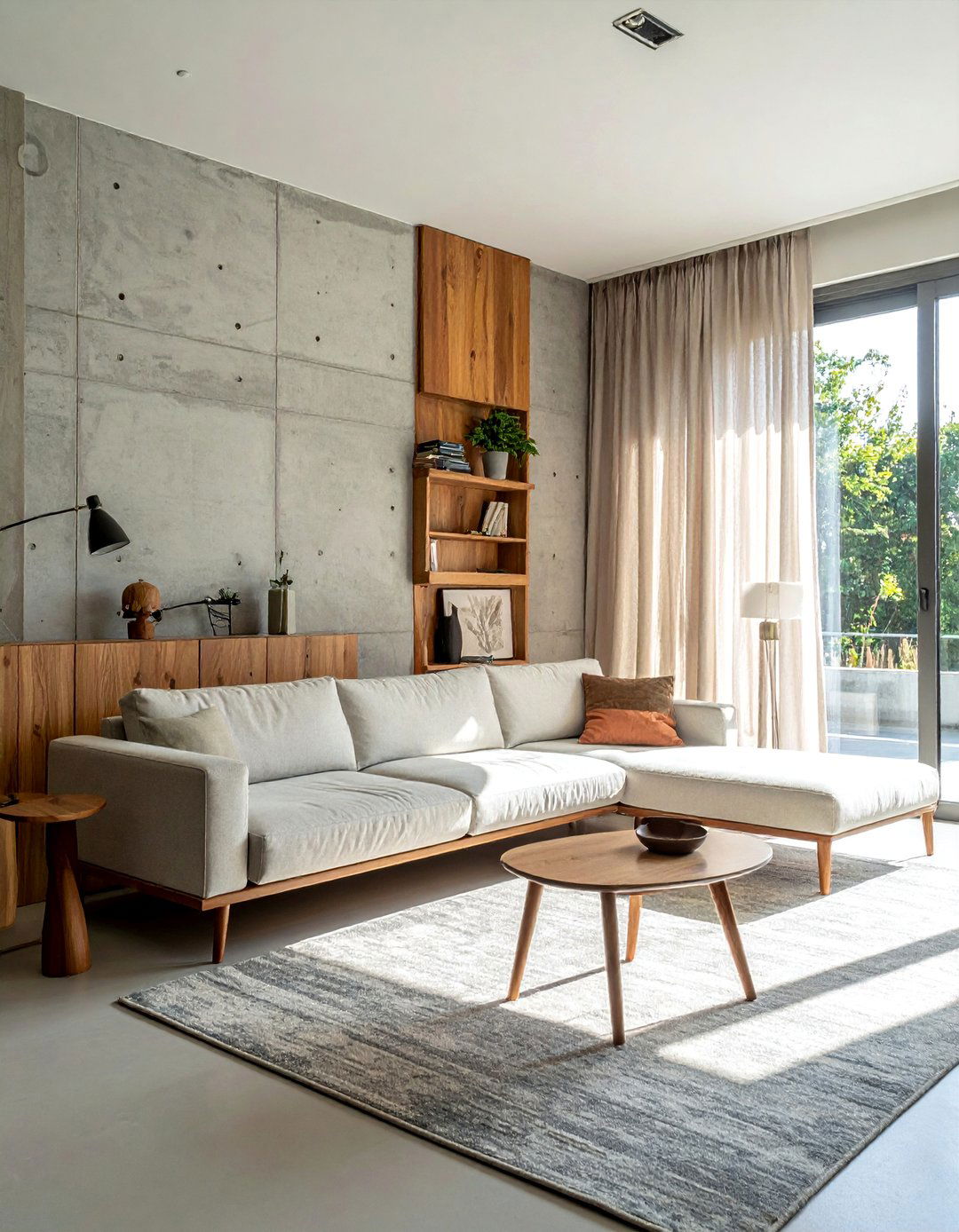
A concrete feature wall becomes the commanding focal point of any brutalist interior. The textured surface showcases the natural imperfections and patterns left by wooden forms during casting, creating an organic canvas that changes with light throughout the day. This approach works beautifully in living rooms, bedrooms, or dining areas where you want to establish a strong visual anchor.
Pair your concrete wall with softer elements like linen curtains, wooden furniture, or plush textiles to balance the harsh industrial feel. The key is allowing the concrete to breathe while surrounding it with materials that add warmth and human comfort. Consider installing subtle lighting that grazes the surface, highlighting the unique textures and creating dramatic shadows that enhance the wall's sculptural quality.
2. Monolithic Furniture Design
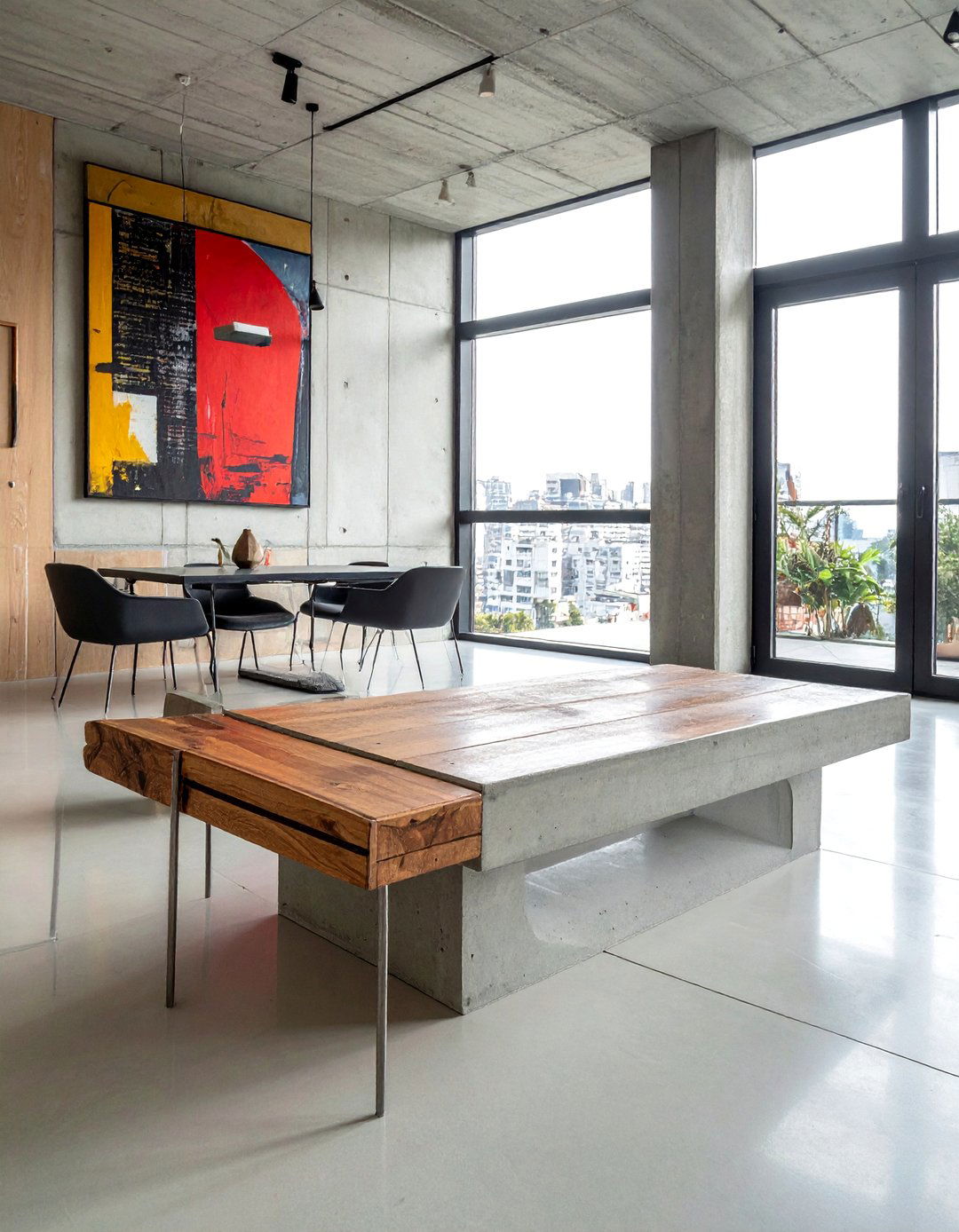
What defines truly brutalist furniture in your living space? Monolithic pieces crafted from solid materials like concrete, steel, or thick wood create the foundation of authentic brutalist interiors. These furniture items appear carved from single blocks, emphasizing weight, permanence, and geometric simplicity over decorative flourishes.
Choose coffee tables, dining tables, or shelving units that showcase clean lines and substantial mass. The beauty lies in their honest construction and functional design. A concrete dining table paired with steel chairs creates an immediate brutalist statement, while wooden benches with thick, unfinished surfaces add warmth without compromising the style's integrity. These pieces should feel like permanent installations rather than temporary additions to your space.
3. Industrial Lighting Fixtures
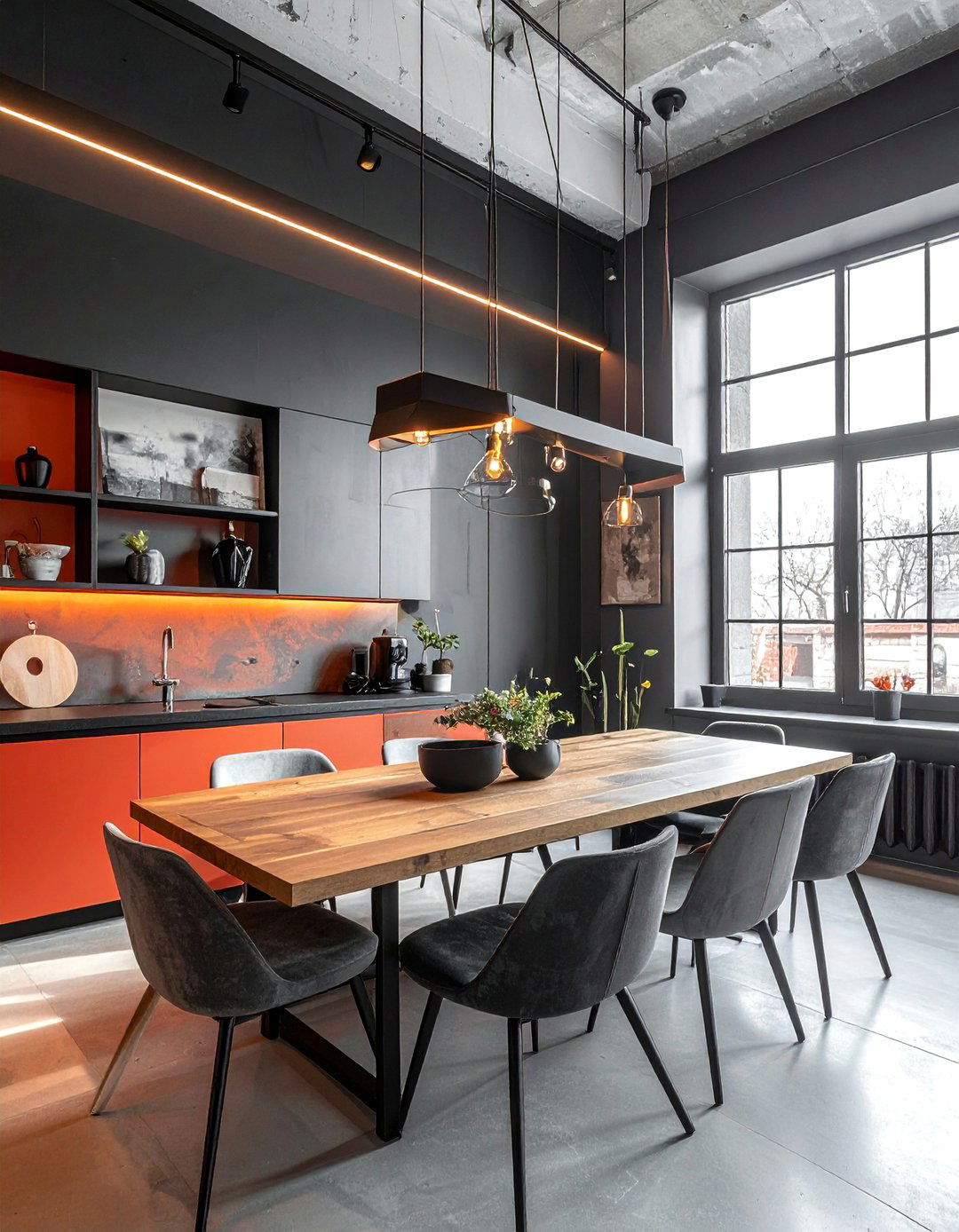
Lighting serves both functional and aesthetic purposes in brutalist design, with fixtures that celebrate mechanical beauty and raw materials. Angular pendant lights, exposed bulb installations, and geometric track lighting systems create the perfect illumination for brutalist spaces while reinforcing the industrial aesthetic.
Metal fixtures in brushed steel, matte black, or aged brass work exceptionally well, especially when they feature bold, geometric shapes. Consider oversized pendant lights over dining areas or sculptural floor lamps that cast interesting shadows across concrete surfaces. The goal is to choose lighting that feels like an integral part of the architecture rather than decorative afterthoughts, maintaining the honest, functional approach that defines brutalism.
4. Minimalist Bedroom Sanctuary

Can a brutalist bedroom feel warm and inviting? Absolutely, when you focus on creating a grounded sanctuary with strong architectural elements and soft, tactile materials. Start with a low platform bed or concrete headboard that emphasizes horizontal lines and substantial form.
Keep furnishings minimal but impactful, choosing pieces that serve clear functions without unnecessary ornamentation. Raw linen bedding, woolen throws, and simple wooden nightstands soften the harder architectural elements. Large windows or skylights flood the space with natural light, while strategic placement of plants adds life and organic shapes. The result is a bedroom that feels both powerful and peaceful, offering a retreat that honors brutalism's honesty while providing genuine comfort.
5. Concrete Bathroom Elements

Brutalist bathrooms embrace the beauty of raw materials through concrete sinks, floors, and shower surrounds that create spa-like environments with industrial edge. Concrete's natural water resistance and durability make it perfect for bathroom applications, while its seamless surfaces eliminate grout lines and create clean, uninterrupted planes.
Polished concrete floors provide subtle reflectivity that enhances natural light, while concrete vanities offer storage and surface space in sculptural forms. Balance these hard surfaces with natural wood accents, soft towels, and carefully chosen fixtures in matte black or brushed metals. The combination creates bathrooms that feel both luxurious and grounded, proving that brutalist design can be both beautiful and practical in wet areas.
6. Steel and Metal Accents

How do you incorporate metal elements without overwhelming your brutalist interior? Steel beams, metal shelving, and iron fixtures add structural honesty while maintaining the movement's emphasis on functional beauty. Exposed steel elements should appear integral to the building's structure rather than purely decorative additions.
Choose metals with natural finishes like weathered steel, brushed stainless steel, or matte black powder coating that complement concrete and wood surfaces. Metal staircases, handrails, and support columns can become sculptural elements that define spaces while serving essential functions. The key is selecting pieces that feel permanent and purposeful, reinforcing brutalism's celebration of honest construction and material authenticity throughout your interior design.
7. Geometric Architectural Forms
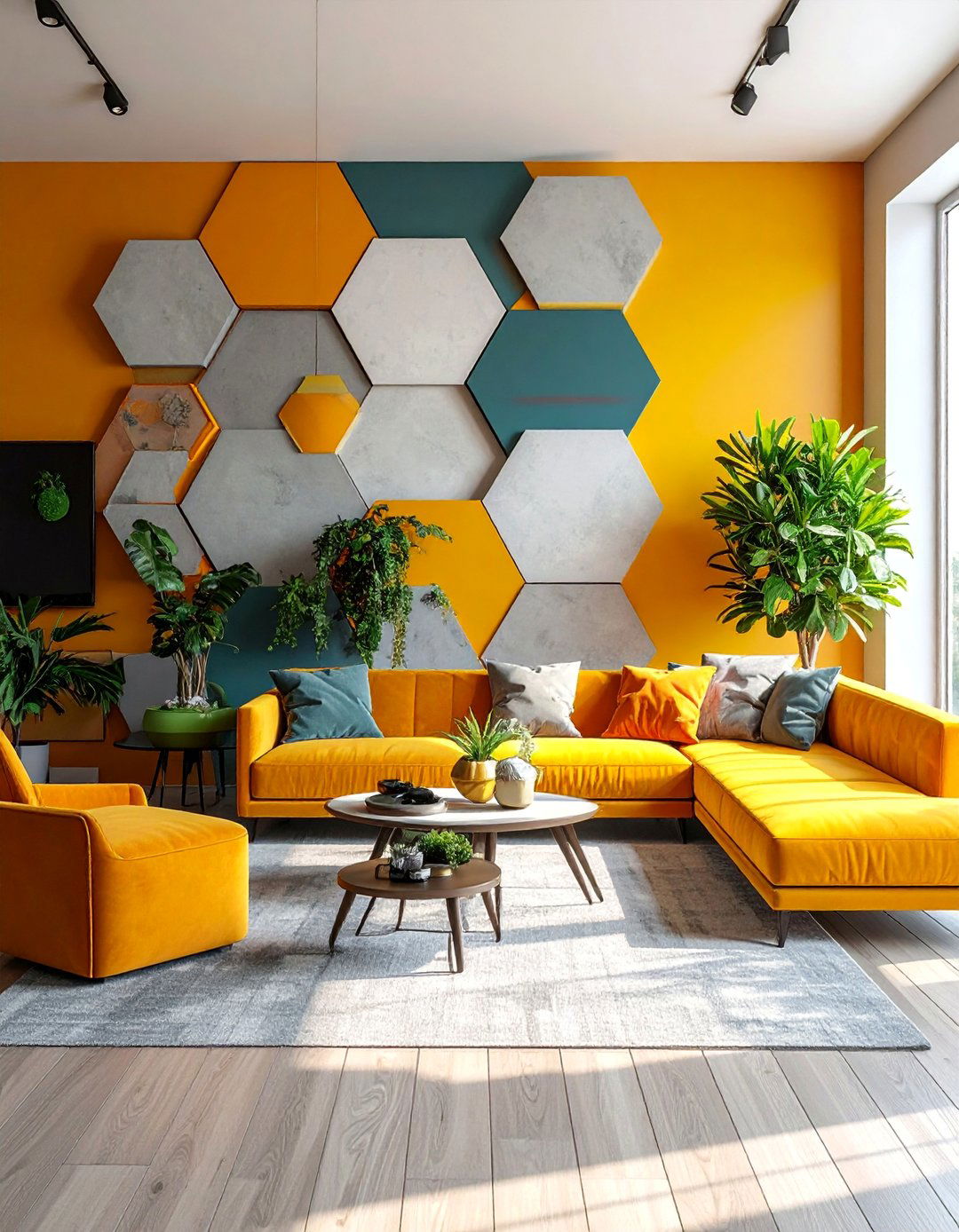
Bold geometric shapes define brutalist interiors through angular furniture, hexagonal tiles, and cubic storage solutions that create visual rhythm and spatial interest. These forms should feel intentional and structural rather than merely decorative, following brutalism's principles of honest design.
Incorporate geometric elements through built-in storage cubes, triangular shelving systems, or rectangular planters that define different areas within open floor plans. Rugs with bold geometric patterns can soften concrete floors while maintaining the angular aesthetic. The goal is creating spaces where geometric forms serve both functional and visual purposes, establishing clear organization and flow while celebrating the mathematical beauty that underlies brutalist architecture.
8. Open Floor Plan Design
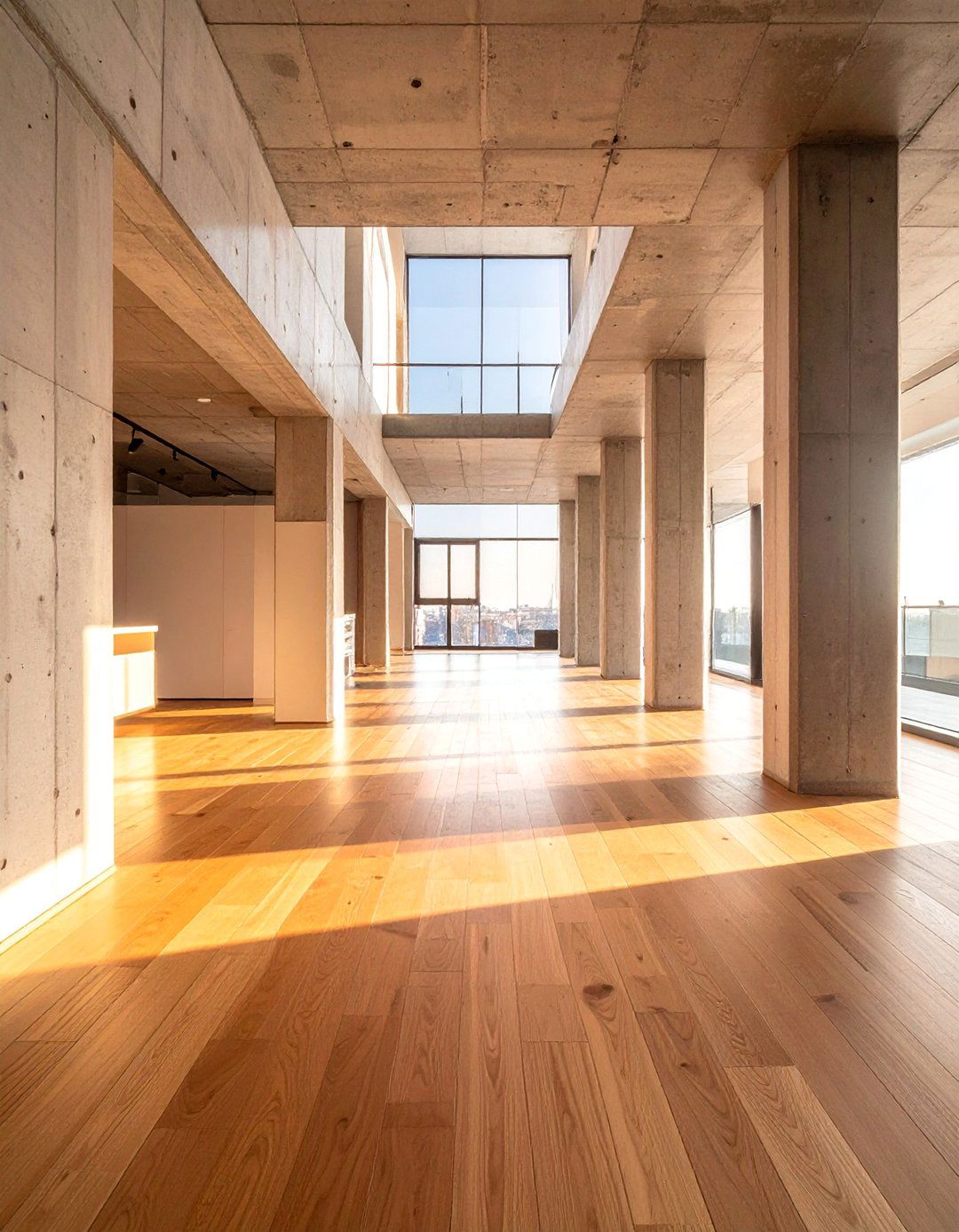
Open layouts emphasize the monumental scale and spatial honesty that characterize brutalist architecture, allowing structural elements like beams and columns to define spaces naturally. Remove unnecessary walls to create flowing areas where furniture arrangement and architectural features establish different zones.
Large, uninterrupted spaces showcase the beauty of raw materials and allow natural light to penetrate deeply into interiors. Use furniture placement, area rugs, and lighting to define living, dining, and work areas without physical barriers. This approach creates homes that feel spacious and honest, where the architecture itself provides all the organization and visual interest needed for comfortable, functional living.
9. Natural Light Integration

Maximizing natural light transforms brutalist interiors from cold industrial spaces into warm, livable environments that celebrate the interplay between architecture and environment. Large windows, skylights, and glass doors create connections between interior and exterior while highlighting the textures and forms of raw materials.
Strategic window placement creates dramatic light and shadow patterns that change throughout the day, adding dynamic visual interest to concrete walls and geometric furniture. Minimal window treatments preserve these effects while providing privacy when needed. The goal is creating spaces where natural light becomes an active design element, enhancing the beauty of brutalist materials while providing the warmth and vitality that make interiors feel alive.
10. Soft Brutalism Textures

What makes brutalism feel cozy and inviting rather than cold and harsh? Soft brutalism introduces tactile materials like wool, linen, and velvet that provide warmth and comfort while respecting the style's architectural integrity. These softer elements should complement rather than fight against the harder structural materials.
Layer plush rugs over concrete floors, add linen curtains to large windows, and choose upholstered furniture in rich, natural fabrics. The contrast between rough concrete and smooth velvet creates visual and tactile interest that makes spaces feel more human and livable. This approach proves that brutalist design can embrace comfort and warmth without compromising its essential character or honest material expression.
11. Exposed Structural Elements

Celebrating exposed beams, ducts, and mechanical systems transforms necessary building components into design features that reinforce brutalist principles of architectural honesty. Rather than hiding these elements, embrace them as sculptural and functional parts of your interior composition.
Exposed concrete beams, steel supports, and even properly designed electrical conduits can become beautiful architectural features when treated with care and intention. Paint mechanical elements in complementary colors or leave them in their natural finishes to maintain authenticity. This approach creates interiors that feel genuine and unpretentious, where every visible element serves a clear purpose and contributes to the overall aesthetic harmony.
12. Monochromatic Color Schemes
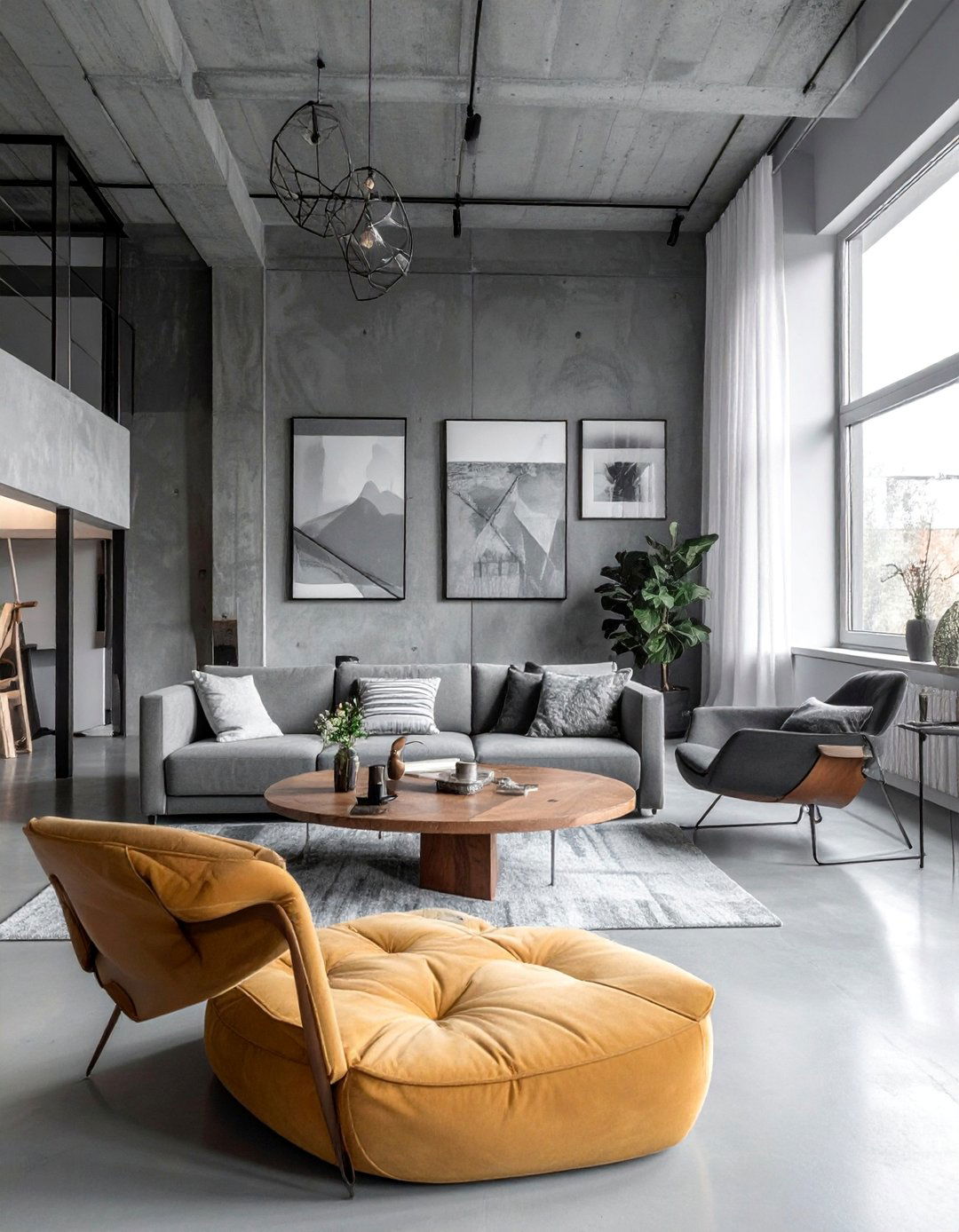
Brutalist color palettes draw from the natural tones of raw materials, creating sophisticated monochromatic schemes that emphasize texture and form over decorative color. Grays, blacks, whites, and natural wood tones provide the foundation for these restrained but rich color stories.
Different shades and tones of the same color family create depth and visual interest without overwhelming the architectural elements. Concrete gray walls might pair with charcoal furniture and white accents, while natural wood tones add warmth throughout. Introduce subtle color through plants, artwork, or textiles, but keep these additions minimal and purposeful to maintain the sophisticated restraint that defines successful brutalist interiors.
13. Functional Kitchen Design

Does your kitchen need to sacrifice beauty for brutalist authenticity? Modern brutalist kitchens prove that functional design can be strikingly beautiful through honest materials and thoughtful organization. Concrete countertops, steel appliances, and minimal cabinetry create efficient workspaces with undeniable character.
Choose appliances and fixtures that emphasize function over decoration, with clean lines and substantial presence. Open shelving displays dishes and tools as functional sculpture, while concrete or steel backsplashes provide durable, easy-to-clean surfaces. The result is a kitchen that feels professional and purposeful, where every element serves cooking and food preparation while contributing to a cohesive, sophisticated aesthetic that celebrates the beauty of useful design.
14. Sculptural Art Integration
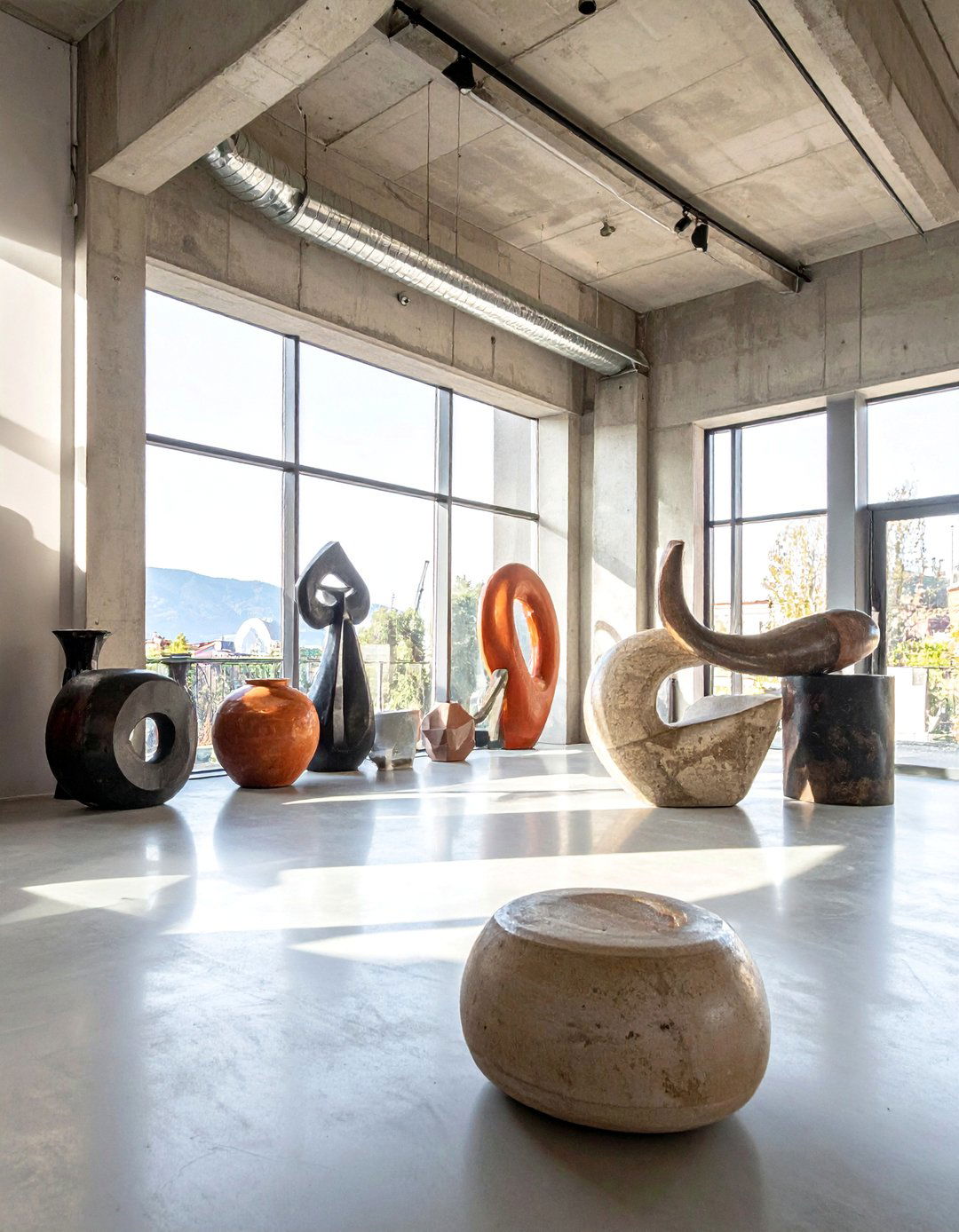
Large-scale sculptural pieces complement brutalist interiors by providing focal points that share the style's emphasis on form, material, and presence. Choose artwork that feels substantial and permanent rather than decorative, with pieces that could stand alone as architectural elements.
Metal sculptures, ceramic vessels, and abstract stone pieces work particularly well in brutalist settings. The key is selecting art that respects the space's architectural character while adding personal expression and visual interest. Fewer, larger pieces create more impact than numerous small items, maintaining the uncluttered aesthetic that allows both architecture and art to be appreciated fully without competition or distraction.
15. Brutalist Office Workspace
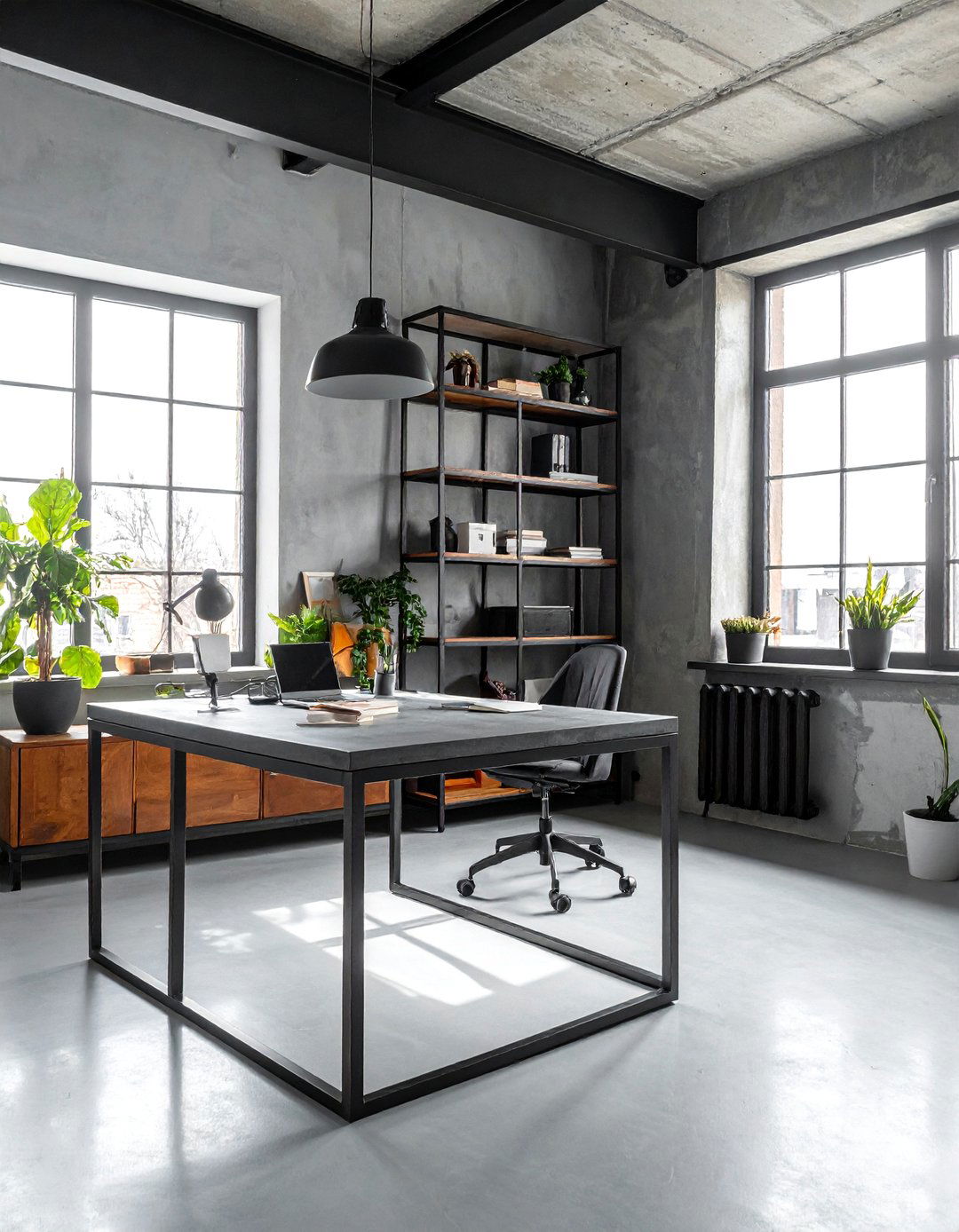
How can you create a productive home office that embraces brutalist design principles? Focus on functional furniture, organized storage, and architectural elements that promote concentration and creativity. A concrete desk, metal shelving, and industrial lighting create a workspace that feels both serious and inspiring.
Choose office furniture that emphasizes clean lines and practical design over decorative elements. Built-in storage solutions maintain the uncluttered aesthetic while providing necessary organization. Large windows provide natural light for work tasks, while the strong architectural elements create an environment that supports focus and productivity. This approach results in home offices that feel professional and purposeful rather than casual or temporary.
16. Outdoor Concrete Features
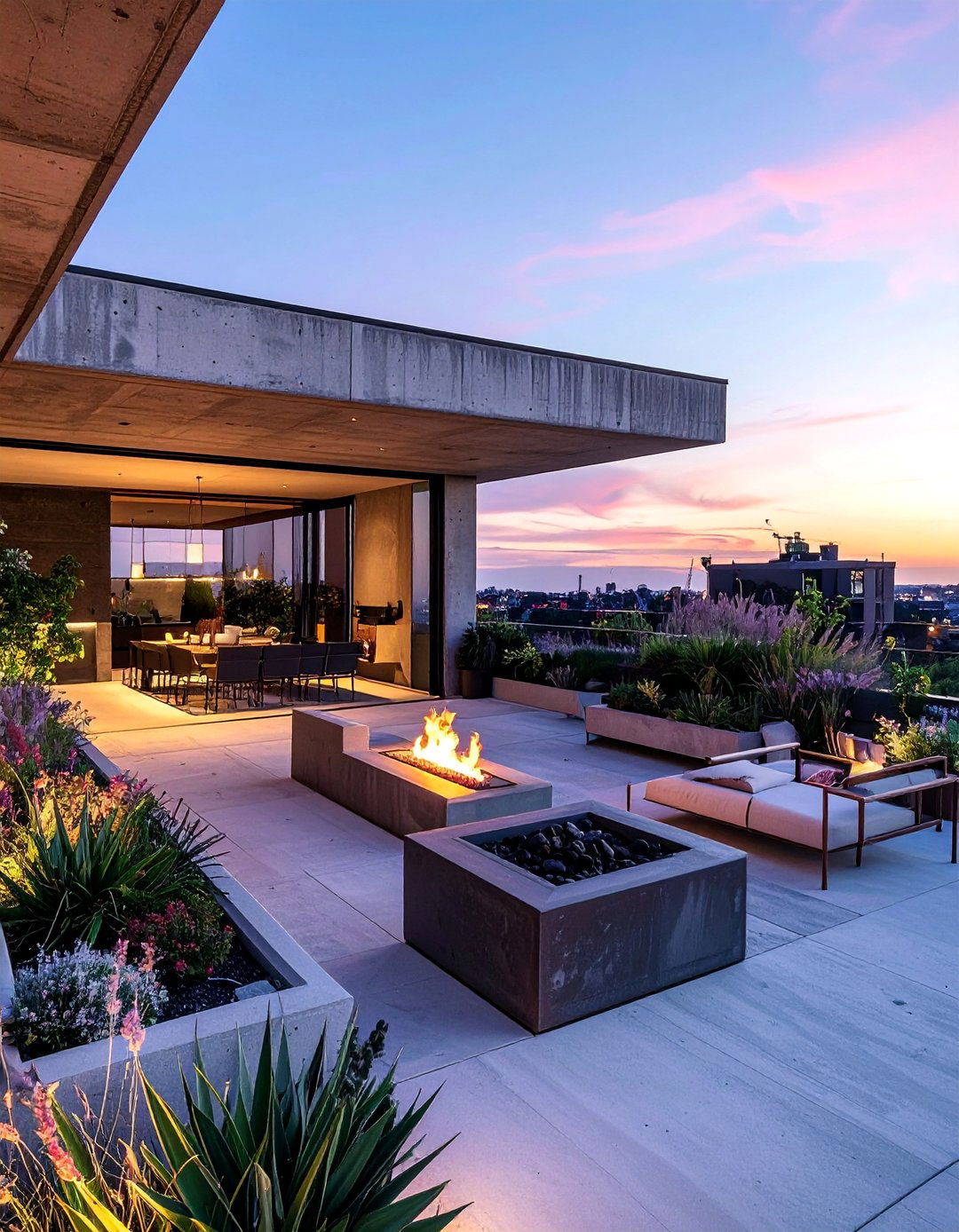
Extending brutalist design outdoors creates seamless connections between interior and exterior spaces through concrete patios, planters, and seating areas. These outdoor elements should feel like natural extensions of your interior design rather than separate decorative additions.
Concrete planters, benches, and fire features provide functional outdoor furniture that weathers beautifully while maintaining the honest material aesthetic. Large concrete pavers or poured surfaces create defined outdoor rooms that relate directly to interior spaces. The goal is creating outdoor areas that feel architecturally integrated with your home's brutalist character while providing comfortable spaces for relaxation and entertainment in natural settings.
17. Mixed Material Contrasts
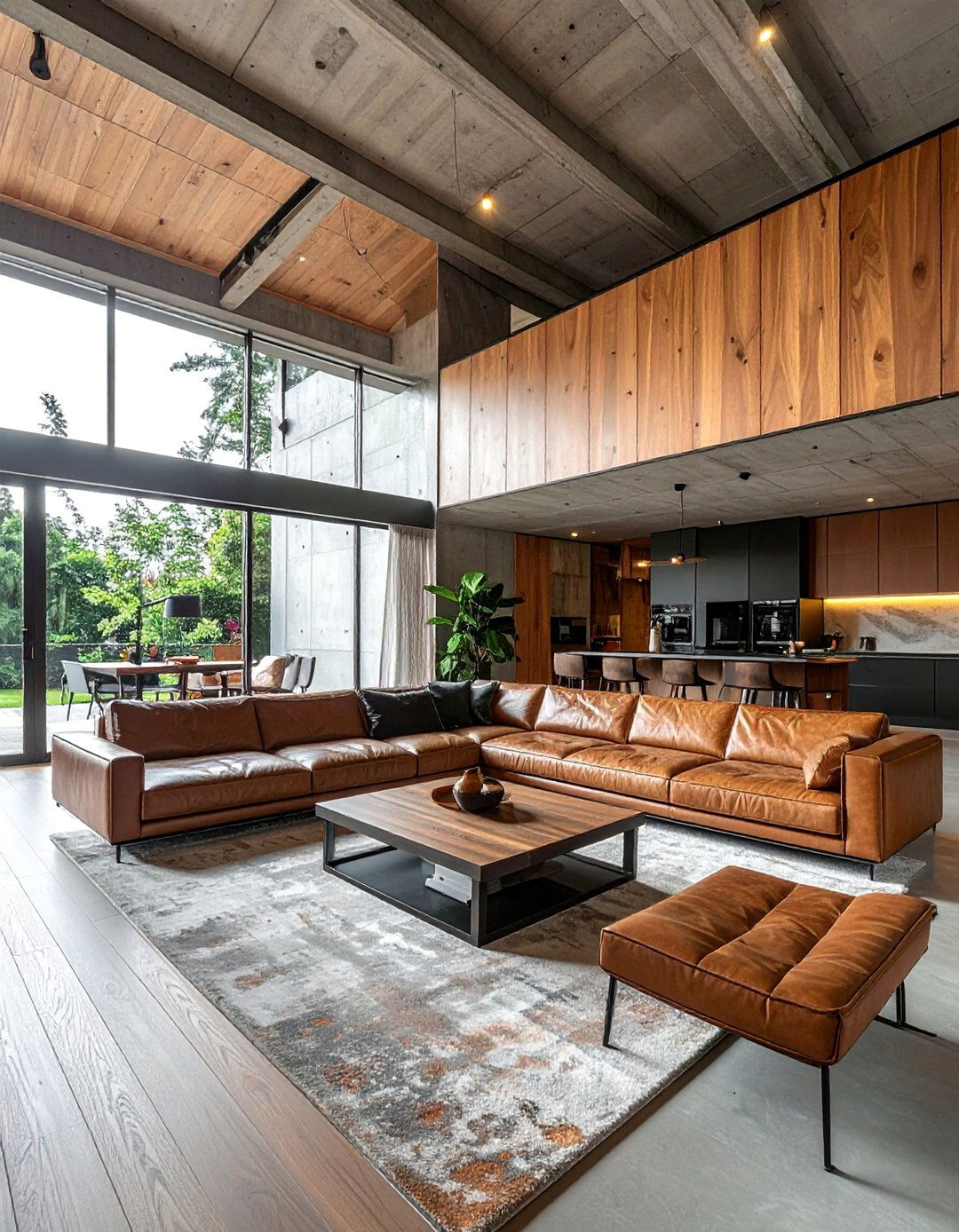
Strategic material combinations create visual interest and warmth in brutalist interiors while maintaining the style's emphasis on honest construction. The key is choosing materials that complement rather than compete, creating harmonious contrasts that enhance each material's unique qualities.
Concrete and wood create particularly effective partnerships, with the warmth of natural wood balancing concrete's coolness. Steel and leather, glass and stone, and similar pairings provide textural variety while respecting brutalist principles. Each material should maintain its authentic character rather than being disguised or treated to look like something else. This approach creates rich, complex interiors that feel both sophisticated and genuine.
18. Eco-Brutalism with Plants
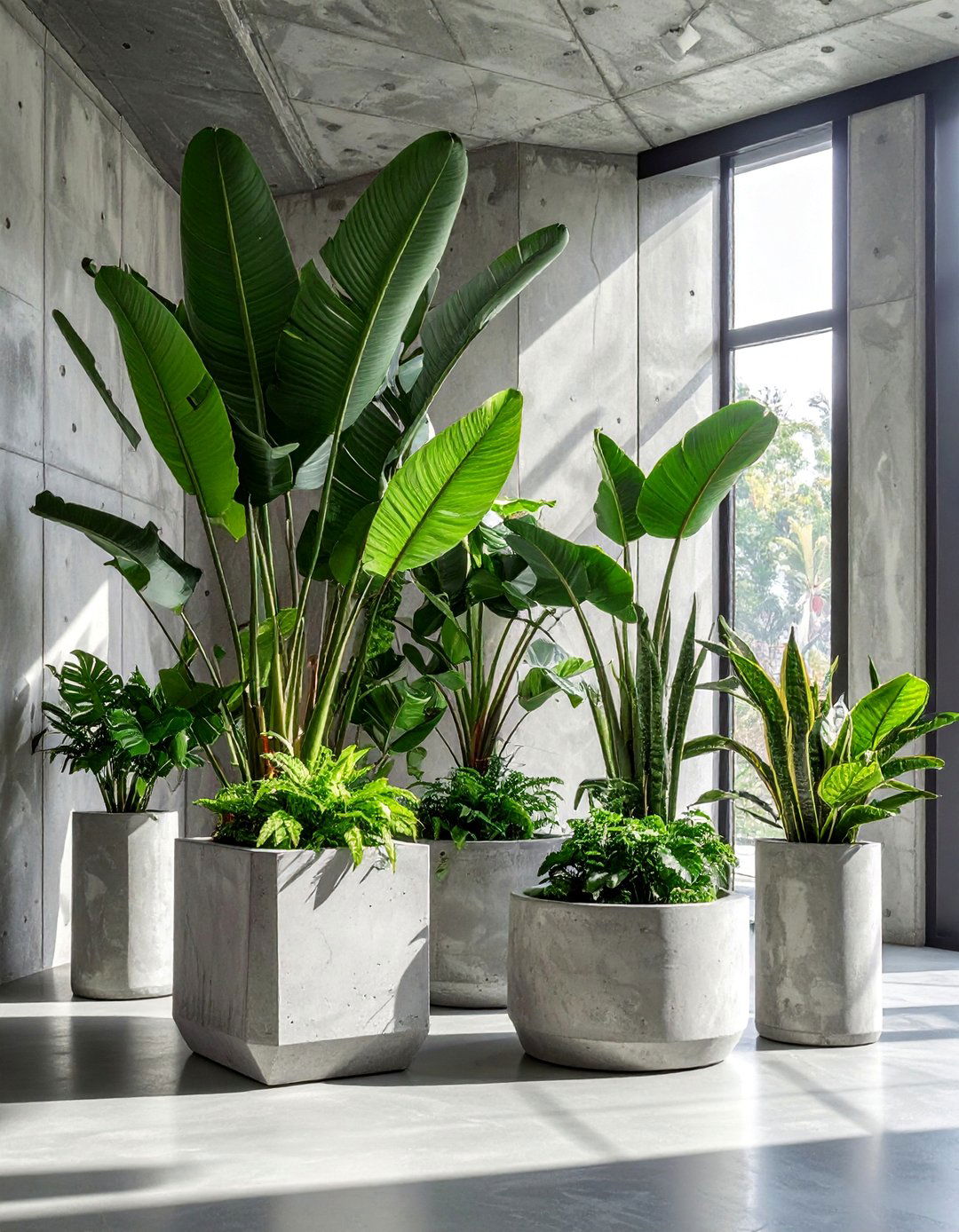
Can brutalist design embrace biophilic elements without compromising its essential character? Eco-brutalism demonstrates how plants and natural elements enhance rather than soften brutalist interiors, creating spaces that feel both grounded and alive. Large-scale plantings in concrete planters provide perfect examples of this integration.
Choose plants with strong architectural forms like fiddle leaf figs, snake plants, or large palms that complement the geometric aesthetic. Concrete planters, steel plant stands, and built-in garden areas maintain the material honesty while introducing organic elements. The contrast between living plants and raw architectural materials creates dynamic, breathing spaces that prove brutalism can embrace nature while maintaining its distinctive character.
19. Textural Wall Treatments
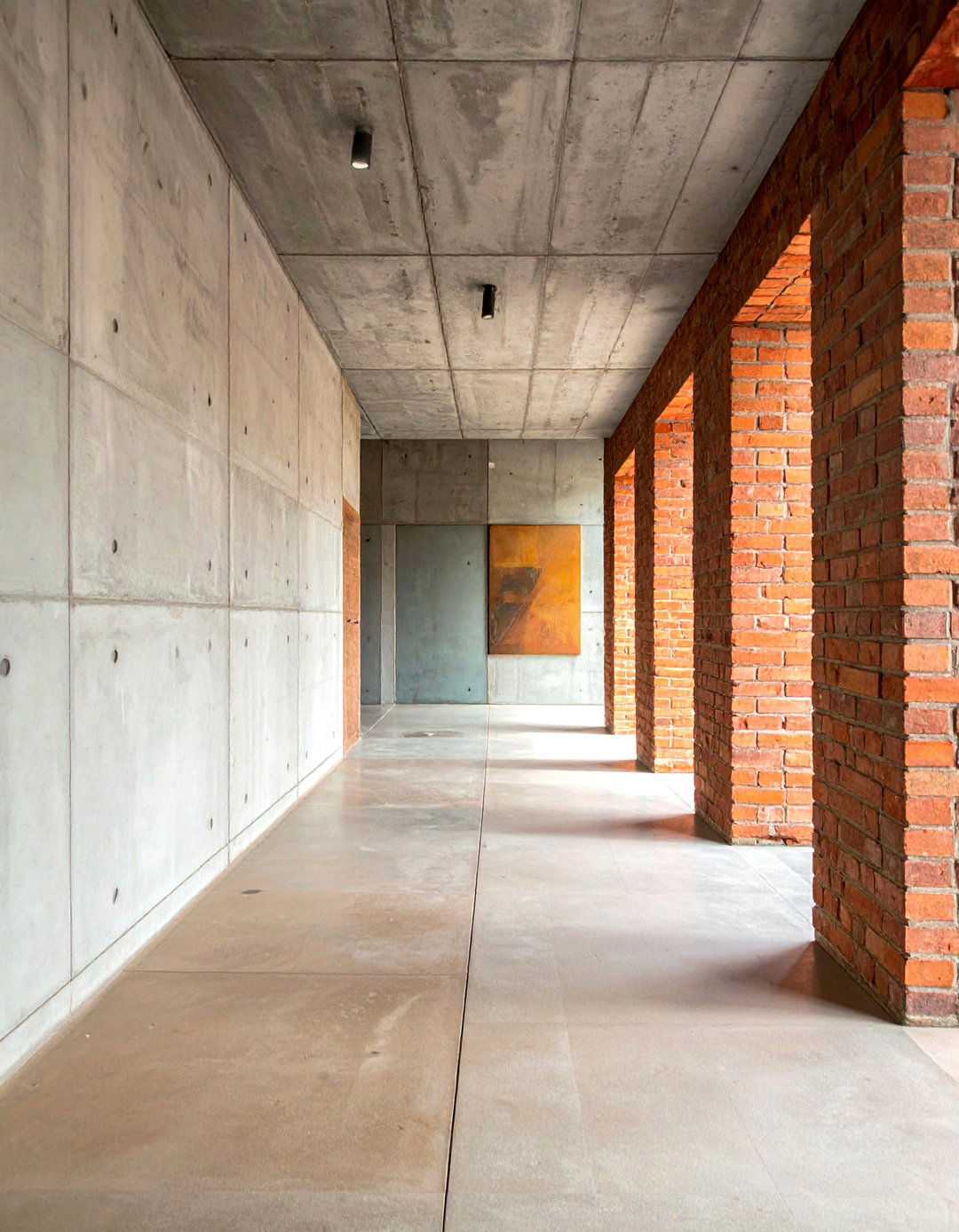
Beyond smooth concrete, brutalist interiors can explore various wall textures that add visual interest while maintaining material authenticity. Board-formed concrete, exposed brick, and natural stone create surfaces that engage both sight and touch while supporting the style's honest material expression.
Different casting techniques create varied concrete textures, from smooth troweled surfaces to deeply grooved board marks. Exposed brick adds warmth and historical connection, while natural stone provides organic texture and color variation. The key is choosing treatments that feel integral to the architecture rather than applied afterward, maintaining the authentic character that makes brutalist design so compelling and enduring.
20. Brutalist Dining Spaces
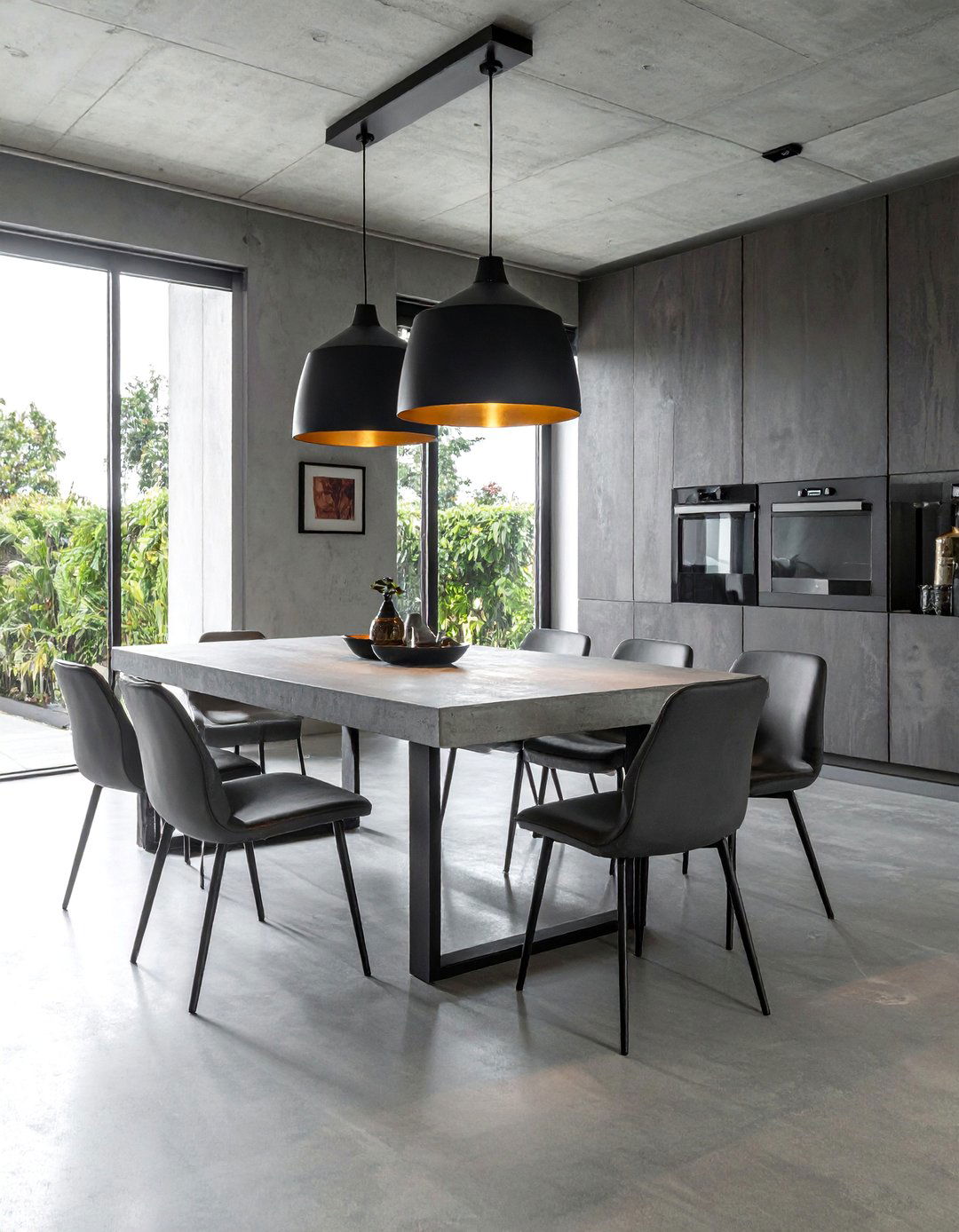
What creates the perfect brutalist dining room for entertaining and everyday meals? Strong architectural elements, functional furniture, and dramatic lighting combine to create dining spaces that feel both ceremonial and comfortable. A massive concrete or wood table becomes the room's focal point and gathering place.
Choose dining chairs that balance comfort with geometric form, using materials like steel, wood, or leather that complement the table and architectural setting. Dramatic pendant lighting or sculptural fixtures provide both illumination and visual interest. The space should feel substantial and permanent, suitable for both intimate family meals and larger gatherings, demonstrating how brutalist design principles create timeless environments for human connection and shared experiences.
Conclusion:
Brutalism interior design offers a powerful alternative to conventional decorating approaches, creating spaces that feel authentic, substantial, and deeply connected to architectural truth. These twenty ideas demonstrate how raw materials, honest construction, and functional beauty can combine to create homes that are both striking and livable. The key to successful brutalist interiors lies in balancing hard architectural elements with softer human comforts, proving that bold design and everyday livability are not mutually exclusive. By embracing concrete, steel, wood, and other honest materials in their natural states, you create environments that age gracefully and maintain their character over time. Whether you choose to implement one dramatic brutalist feature or transform your entire home, these approaches will help you achieve spaces that feel both timeless and thoroughly contemporary.


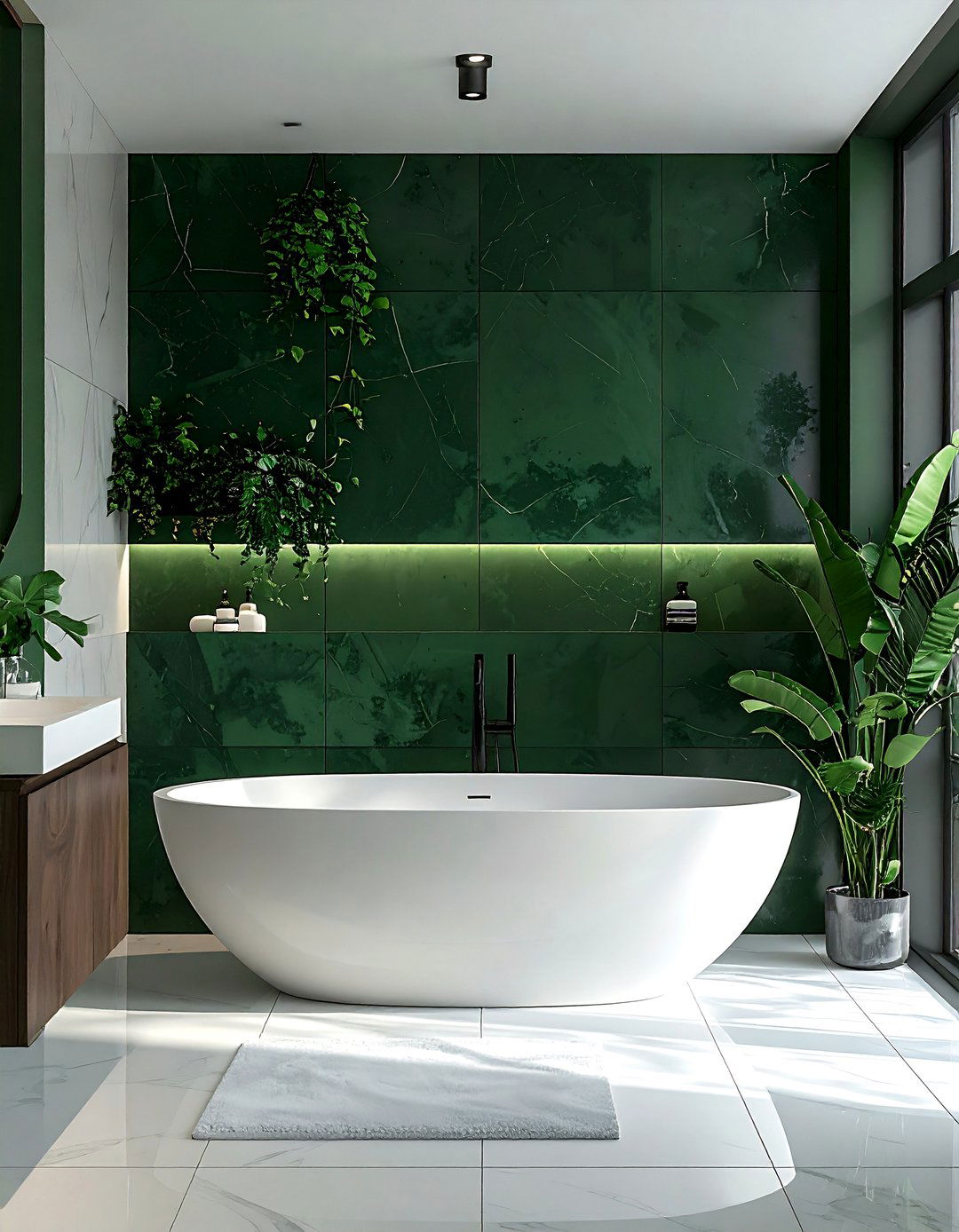




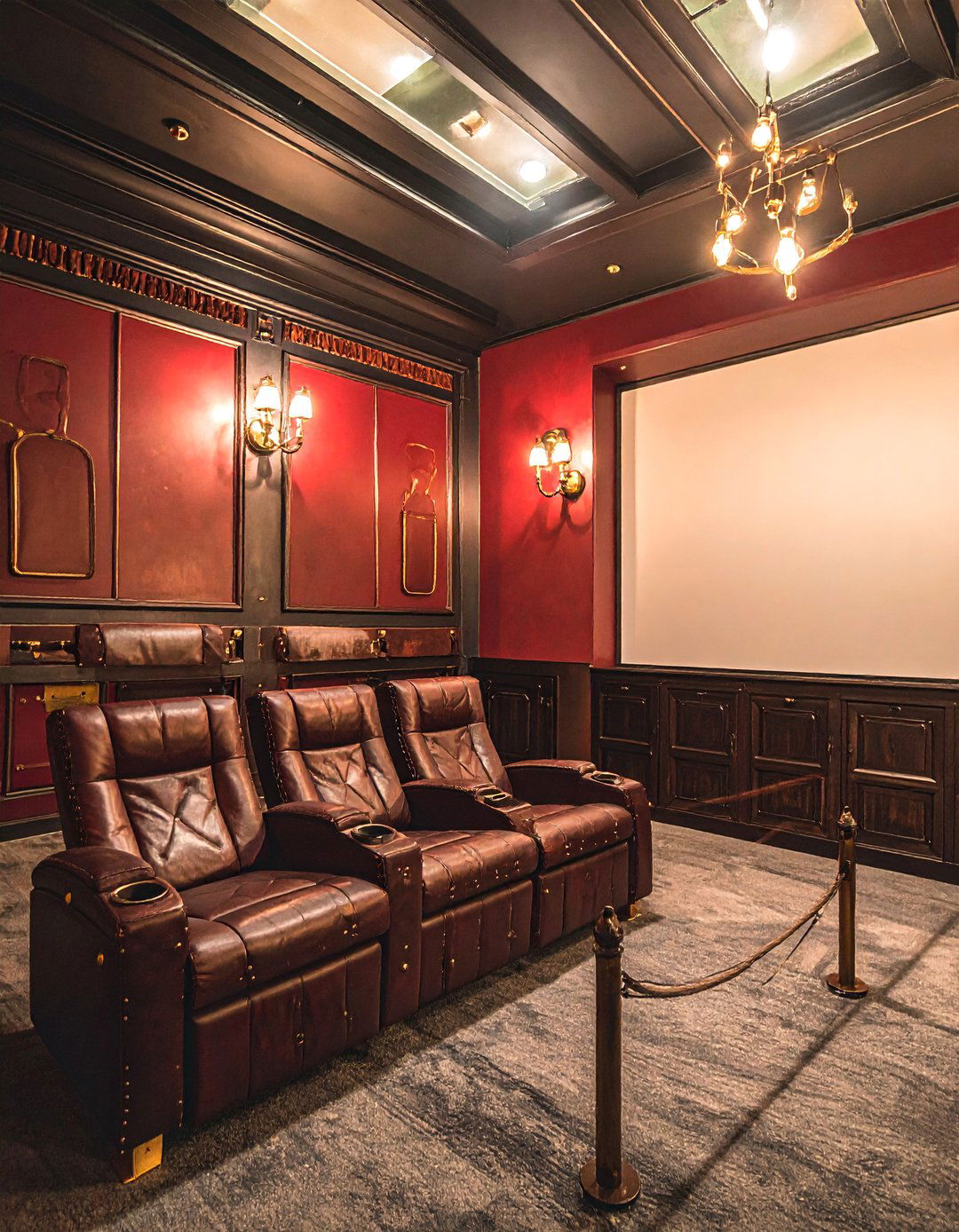

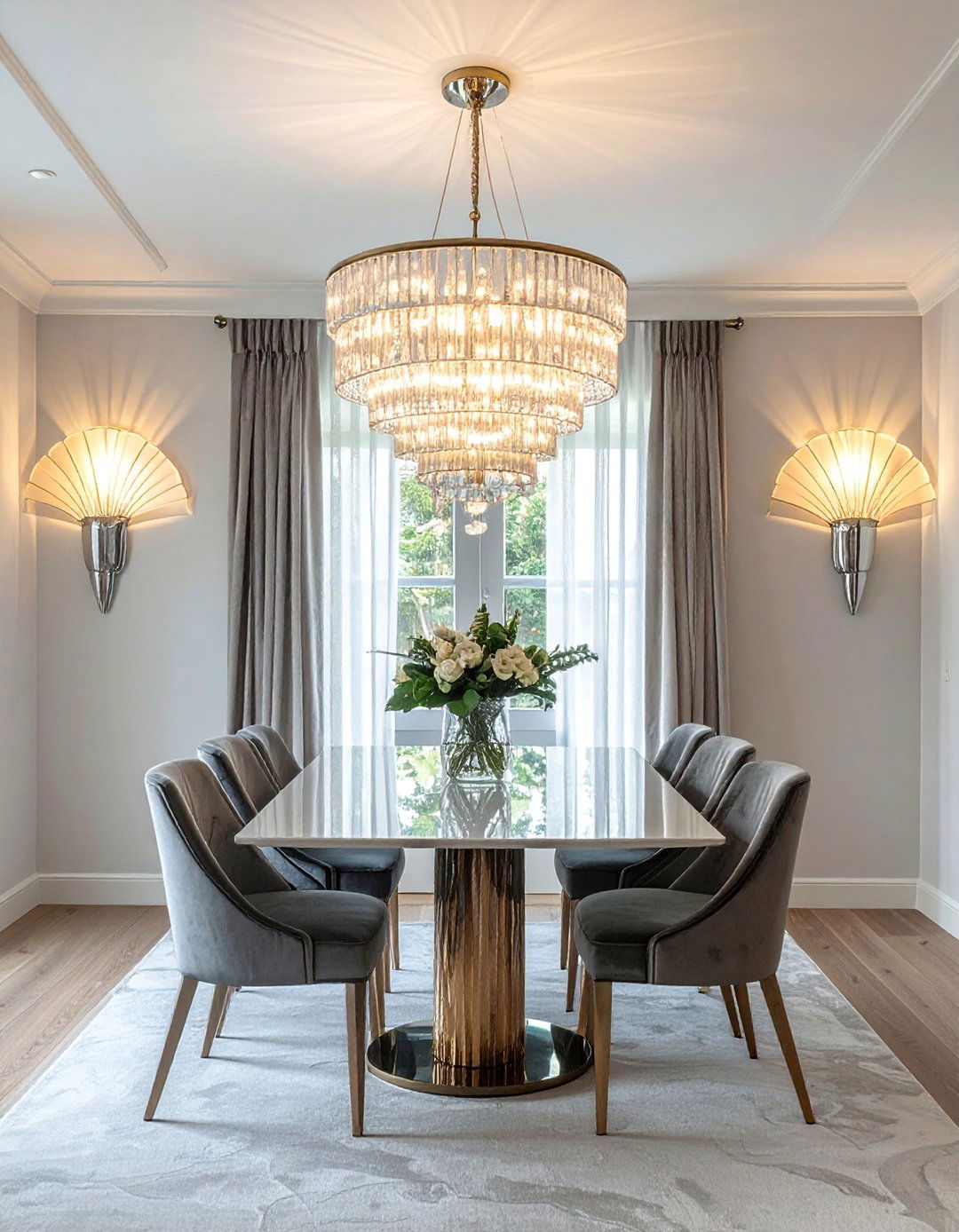
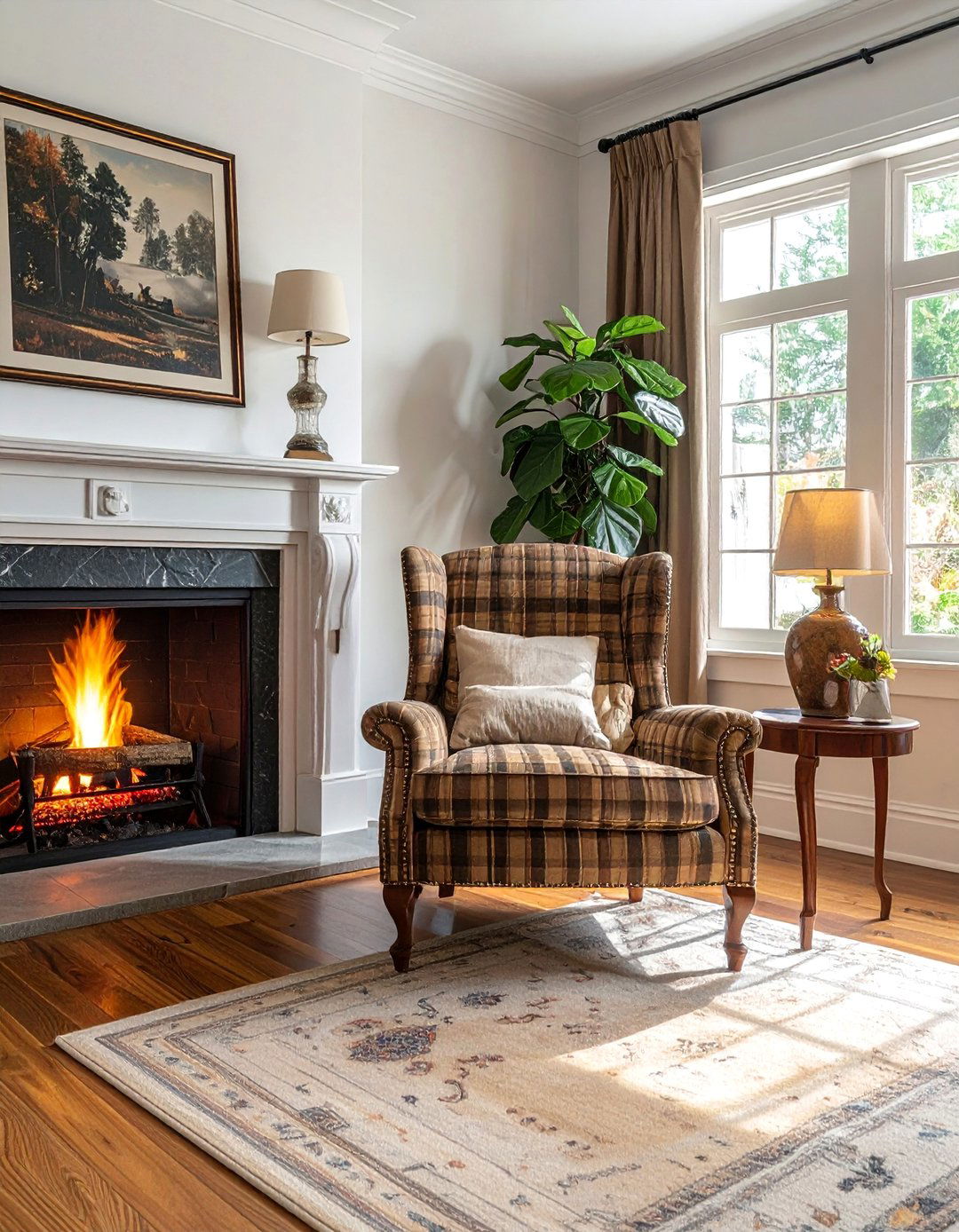
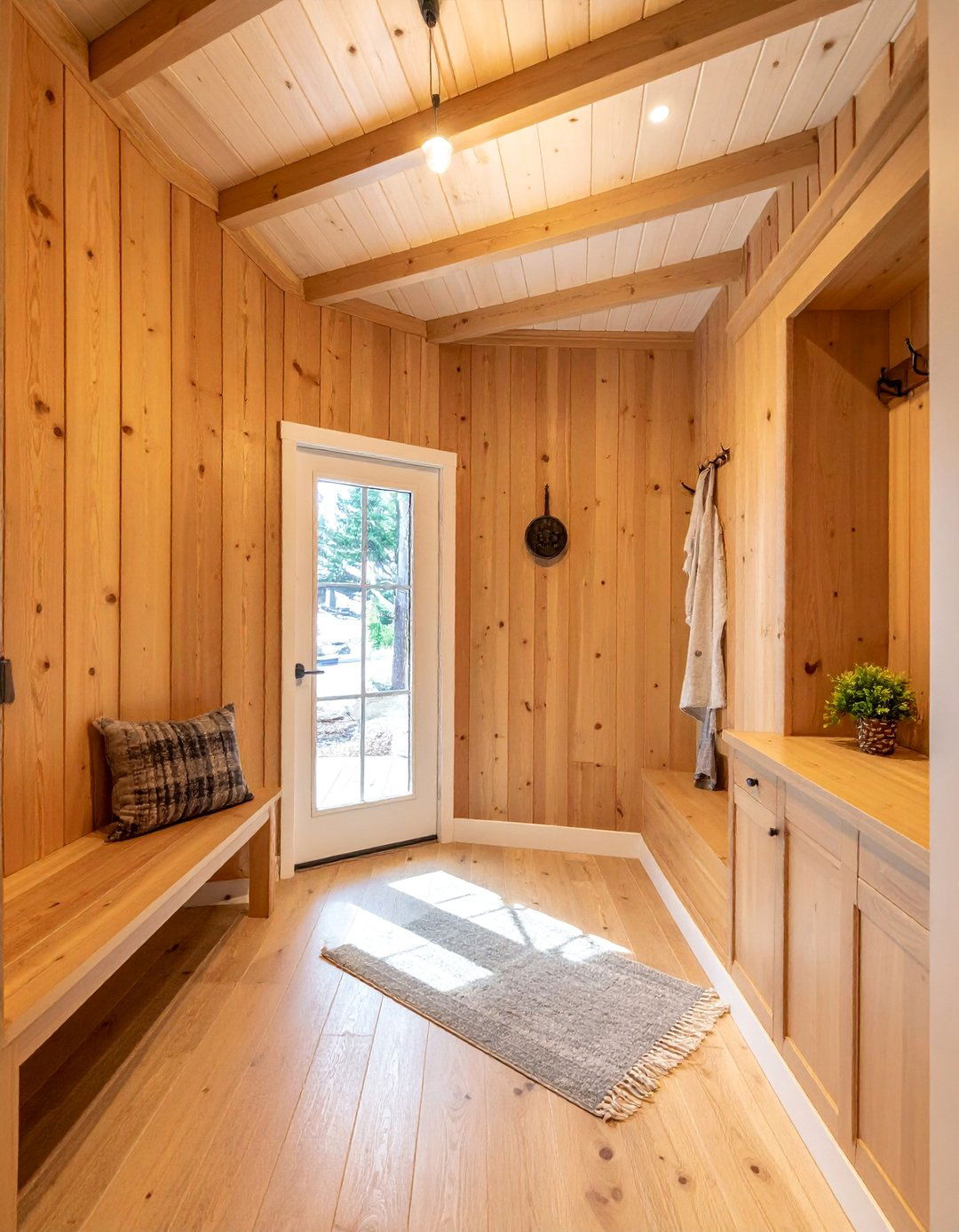
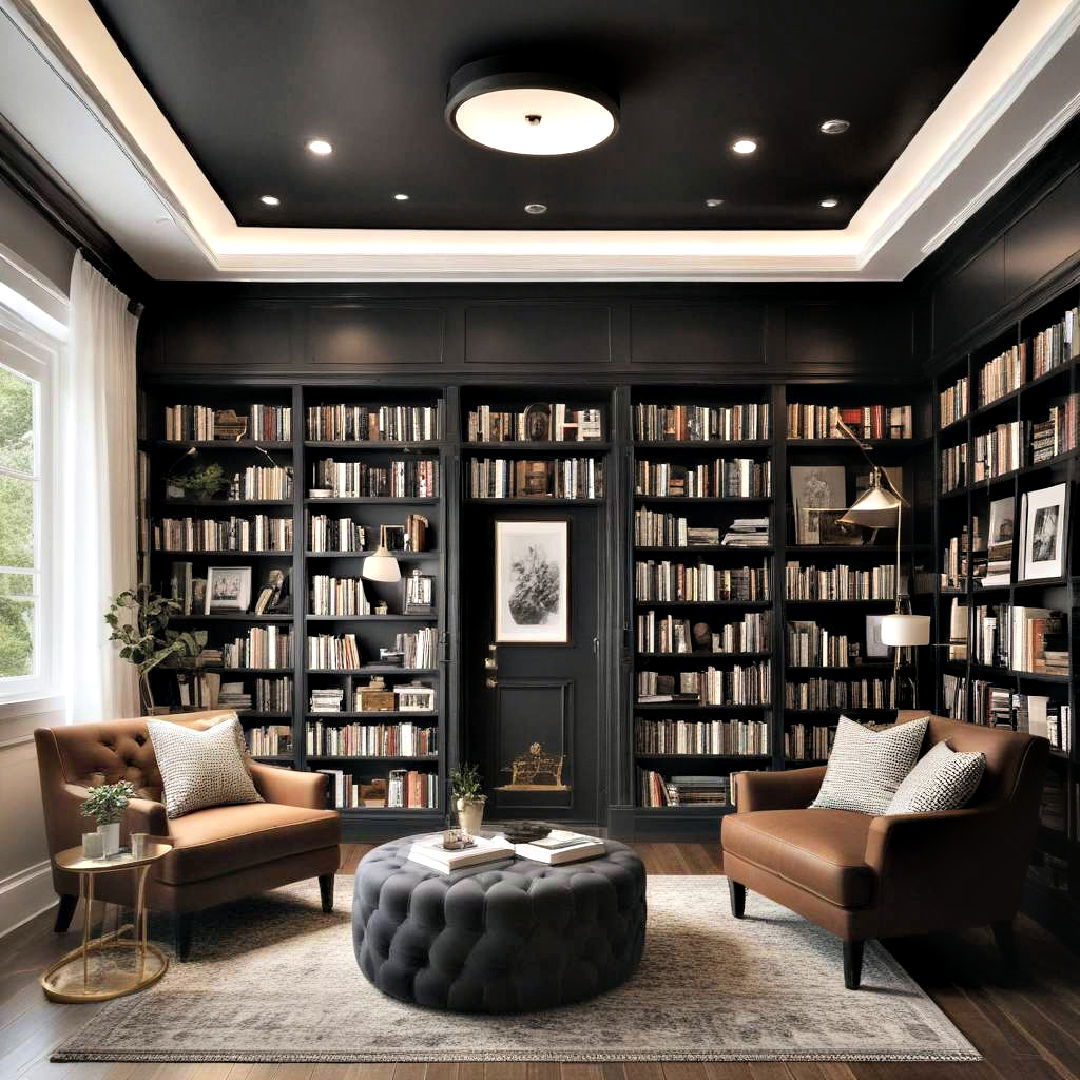
Leave a Reply